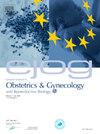通过胎动加速测量记录仪计算胎动增加后的围产期结局
IF 1.7
Q3 OBSTETRICS & GYNECOLOGY
European Journal of Obstetrics and Gynecology and Reproductive Biology: X
Pub Date : 2025-09-11
DOI:10.1016/j.eurox.2025.100428
引用次数: 0
摘要
关于胎动增加意味着什么,围产期医学尚无共识。目的研究围产期结局与用客观方法计算的胎动量增加之间的关系。方法前瞻性队列研究。孕28周后,每周用胎动加速记录仪记录471例孕妇夜间胎动。当一晚可以记录到4次 h以上的胎动时,计算10秒胎动时间与所有胎动时间的比值作为胎动参数。如果该参数高于之前制作的参考曲线的第90个百分位数,则定义为运动增加。表现出至少一次胎动增加的妇女被分为研究组,其他妇女被分为对照组。采用卡方检验或Fisher精确检验比较两组围产儿异常情况。结果390例女性共记录13931 h,其中研究组74例,对照组316例。研究组的早产(1.4 %)、分娩时的非头位表现(0 %)和剖宫产(25.7 %)均少于对照组(15.5 %、6.0 %和39.9 %;p = 0.0003、0.031和0.024)。其他围产儿结局无显著差异。结论长期胎动量增加对早产、非头位分娩和剖宫产均有保护作用。本文章由计算机程序翻译,如有差异,请以英文原文为准。
Perinatal outcomes after increased fetal movement as counted by a fetal movement acceleration measurement recorder
Introduction
There is no consensus in perinatal medicine about what increased fetal movement means.
Objective
Our purpose was to study the relationship between perinatal outcomes and an increase in gross fetal movement as counted by an objective method.
Methods
This was a prospective cohort study. A total of 471 pregnant women recorded fetal movement with a fetal movement acceleration measurement recorder at night weekly after 28 weeks. The ratio of 10-second epochs with fetal movement to all epochs was calculated as a fetal movement parameter when movement could be recorded for more than 4 h on one night. If the parameter was above the 90th percentile on the previously made reference curve, it was defined as increased movement. Women who showed the increased fetal movement at least once were classified into a study group, and the other women were classified into a control group. Perinatal abnormalities between the two groups were compared with the Chi-square test or Fisher’s exact test.
Results
A total of 13,931 h were recorded from 390 women, including 74 and 316 women, respectively, in the study and control groups. There were fewer preterm births (1.4 %), non-cephalic presentations at delivery (0 %), and Cesarean deliveries (25.7 %) in the study group than in the control group (15.5 %, 6.0 %, and 39.9 %; p = 0.0003, 0.031, and 0.024, respectively). There were no significant differences in the other perinatal outcomes.
Conclusion
An increase in long-term gross fetal movement has a protective effect against preterm birth, non-cephalic presentation at birth, and Cesarean delivery.
求助全文
通过发布文献求助,成功后即可免费获取论文全文。
去求助
来源期刊

European Journal of Obstetrics and Gynecology and Reproductive Biology: X
Medicine-Obstetrics and Gynecology
CiteScore
2.20
自引率
0.00%
发文量
31
审稿时长
58 days
 求助内容:
求助内容: 应助结果提醒方式:
应助结果提醒方式:


